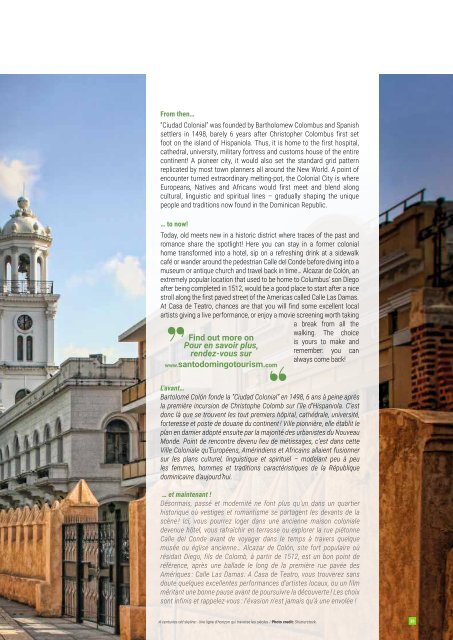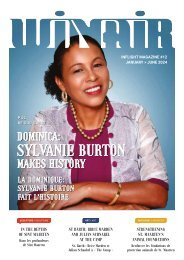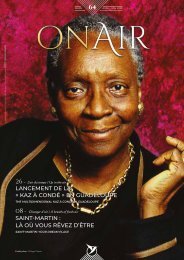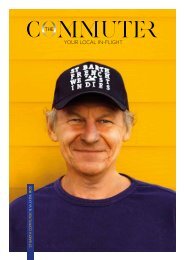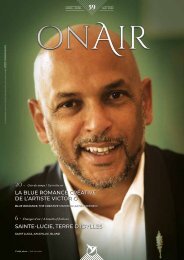Create successful ePaper yourself
Turn your PDF publications into a flip-book with our unique Google optimized e-Paper software.
From then…<br />
“Ciudad Colonial” was founded by Bartholomew Colombus and Spanish<br />
settlers in 1498, barely 6 years after Christopher Colombus first set<br />
foot on the island of Hispaniola. Thus, it is home to the first hospital,<br />
cathedral, university, military fortress and customs house of the entire<br />
continent! A pioneer city, it would also set the standard grid pattern<br />
replicated by most town planners all around the New World. A point of<br />
encounter turned extraordinary melting-pot, the Colonial City is where<br />
Europeans, Natives and Africans would first meet and blend along<br />
cultural, linguistic and spiritual lines – gradually shaping the unique<br />
people and traditions now found in the Dominican Republic.<br />
… to now!<br />
Today, old meets new in a historic district where traces of the past and<br />
romance share the spotlight! Here you can stay in a former colonial<br />
home transformed into a hotel, sip on a refreshing drink at a sidewalk<br />
café or wander around the pedestrian Calle del Conde before diving into a<br />
museum or antique church and travel back in time… Alcazar de Colón, an<br />
extremely popular location that used to be home to Columbus’ son Diego<br />
after being completed in 1512, would be a good place to start after a nice<br />
stroll along the first paved street of the Americas called Calle Las Damas.<br />
At Casa de Teatro, chances are that you will find some excellent local<br />
artists giving a live performance, or enjoy a movie screening worth taking<br />
a break from all the<br />
Find out more on<br />
Pour en savoir plus,<br />
rendez-vous sur<br />
www.santodomingotourism.com<br />
walking. The choice<br />
is yours to make and<br />
remember: you can<br />
always come back!<br />
L’avant…<br />
Bartolomé Colón fonde la “Ciudad Colonial” en 1498, 6 ans à peine après<br />
la première incursion de Christophe Colomb sur l’île d’Hispaniola. C’est<br />
donc là que se trouvent les tout premiers hôpital, cathédrale, université,<br />
forteresse et poste de douane du continent ! Ville pionnière, elle établit le<br />
plan en damier adopté ensuite par la majorité des urbanistes du Nouveau<br />
Monde. Point de rencontre devenu lieu de métissages, c’est dans cette<br />
Ville Coloniale qu’Européens, Amérindiens et Africains allaient fusionner<br />
sur les plans culturel, linguistique et spirituel – modelant peu à peu<br />
les femmes, hommes et traditions caractéristiques de la République<br />
dominicaine d’aujourd’hui.<br />
… et maintenant !<br />
Désormais, passé et modernité ne font plus qu’un dans un quartier<br />
historique où vestiges et romantisme se partagent les devants de la<br />
scène ! Ici, vous pourrez loger dans une ancienne maison coloniale<br />
devenue hôtel, vous rafraîchir en terrasse ou explorer la rue piétonne<br />
Calle del Conde avant de voyager dans le temps à travers quelque<br />
musée ou église ancienne… Alcazar de Colón, site fort populaire où<br />
résidait Diego, fils de Colomb, à partir de 1512, est un bon point de<br />
référence, après une ballade le long de la première rue pavée des<br />
Amériques : Calle Las Damas. A Casa de Teatro, vous trouverez sans<br />
doute quelques excellentes performances d’artistes locaux, ou un film<br />
méritant une bonne pause avant de poursuivre la découverte ! Les choix<br />
sont infinis et rappelez-vous : l’évasion n’est jamais qu’à une envolée !<br />
A centuries-old skyline - Une ligne d’horizon qui traverse les siècles / Photo credit: Shutterstock.<br />
23


